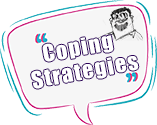Like us on Follow Us on
Follow Us on  Caregiver Blog
Caregiver Blog![]()
DISCLAIMER ...
There is no hard and fast answer to addressing a problem behaviour.
The following information is provided as a tool to help the Caregiver find the solution that works for situation they are faced with.
Problem Behaviours - Sleeping
| Possible Causes | Coping Strategies | Other Considerations | Additional Information
Being a Caregiver at home is a difficult task and can become overwhelming at times. Each day brings new challenges as the caregiver copes with changing levels of ability and new patterns of behavior. For the exhausted caregiver, sleep can’t come too soon. Many caregivers cite sleep disturbances, including night wandering and confusion, as the reason for institutionalizing the elderly.
The problem with Alzheimer's disease, as well as other forms of dementia, is that the disease has negative effects on the sleep/wake cycle.
The greater the degree of dementia, the sleepier the patient is. With more severe forms of dementia, patients are often sleepier during the day, and their sleep at night tends to be fragmented and disrupted. Over a 24-hour period, for example, patients are rarely awake and rarely asleep for a full hour at a time. They are constantly waking up at night and falling asleep during the day.
This pattern is fairly common in Alzheimer's patients.
Scientists don't completely understand why sleep disturbances occur with Alzheimer's disease and dementia. As with changes in memory and behavior, sleep changes somehow result from the impact of Alzheimer's on the brain. Some studies indicate as many as 20 percent of persons with Alzheimer's will experience increased confusion, anxiety and agitation beginning late in the day. Others may experience changes in their sleep schedule and restlessness during the night. This disruption in the body's sleep-wake cycle can lead to more behavioral problems.
Physiological or Medical Causes
- The ability to sleep appears to deteriorate as cognitive abilities decline.
Environmental Causes
Other Causes
TOP
- Treat pain with an analgesic (Aspirin, Motrin®, Tylenol®, Nuprin® or Advil®) at bedtime, if approved by doctor.
- Try Vitamin E for "restless legs".
- Also discuss with doctor stopping or changing diuretic medications that may be contributing to this problem.
- For sleep apnea (breathing difficulties characterized by heavy snoring) help person lose weight if obese.
- See doctor and discuss eliminating sedatives that may be contributing to this problem.
- Continue bedtime rituals from the past (e.g., a glass of milk before bed, or music on radio at bedtime).
- For others, however, they may be confusing and may lead to falls if person tries to climb out of bed.
Make the house, or an area of the house, safe for the person to wander in alone at night.
- Gating off stairs;
- Special locks or alarms on doors to outside;
- Locking off kitchen or locking up dangerous items;
- Making sure windows are locked.
For sundowning (agitation and wandering in late afternoon/evening):
The term "Sundowning" refers to a state of confusion at the end of the day and into the night. Sundowning isn't a disease, but a symptom that often occurs in people with dementia. (Click Here to navigate to Tip Page)
Factors that may aggravate late-day confusion include:
Coping Strategies may include:
Research suggests that a low dose of melatonin — a naturally occurring hormone that induces sleepiness — in combination with exposure to bright light during the day may help minimize the disorientation associated with sundowning. When sundowning occurs in a care facility, it may be related to the flurry of activity during staff shift changes. Staff arriving and leaving may cue some people with Alzheimer's to want to go home or to check on their children — or other behaviors that were appropriate in the late afternoon in their past. It may help to occupy their time during that period.
In nursing homes or adult foster care homes:
General:
- Be aware that their effectiveness is only short term, but may be helpful in establishing a more regular sleep cycle.
TOP
Other Considerations
Alzheimer's Association (ADRDA) chapter newsletters
Davignon, Denise and Pauline Bruno. Insomnia: Causes and Treatment, Particularly in the Elderly. Journal of Gerontological Nursing, 8(6), 1982.
Lerner, Roslyn. Sleep Loss in the Aged: Implications for Nursing Practice. Journal of Geronrological Nursing, 8(6), 1982.
Mace, Nancy and Peter Rabins. The 36-Hour Day. Baltimore: The Johns Hopkins University Press, 1981.
Reynolds, Charles, David Kupfer, and Deborah Sewitch. Diagnosis and Management of Sleep Disorders in the Elderly. Hospital and Community Psychiatry, 35 (8), 1984
TOP
OUR STORY
A Family Reflection And A Promise Kept
THE CAREGIVER ROLE
What is a Caregiver
The Caregiver Defined
Who Do Caregivers Care For
Accepting the Reality of Dementia
6 Steps to Successful Caregiving
Caregiver's Are Not Alone
Asking For & Getting Help
The Caregiver Code
Rights of a Caregiver
General Suggestions
Unmet Needs Of A Caregiver
Caregiver And Work
Feelings And Caregiver Stress
Questions & Answers
Notable People
STRESS, COPING & FEELINGS
The Caregiver Code
Rights of The Caregiver
Coping With Stress
Feelings And Caregiver Stress
Stages Of Alzheimer's
Helping Children Understand
Caregiver Burnout
Protecting Yourself From Burnout
Making Time For Reflection
Moving On
How is Competency Defined?
Power of Attorney
What is an Advanced Directive?
Do I Really Need a Will or a Trust?
COMMUNICATION
Importance of Communication
Communicating With Someone Who Has Alzheimer's
Your Approach Sets The Tone
Think Before You Speak
Doing Tasks Together
Having Trouble Being Understood
Keeping a Dementia Journal
Making Caregiving Easier - Caregiver Notebook
Things NOT To Do
When It Just Fails
ALZHEIMER'S BASICS
What is Alzheimer's
Why is Alzheimer's Different
Stages of Alzheimers
Can Alzheimers be Inherited
Statistics
The Mortality Question
TIPS AND ISSUES
New To Family Caregiving?
Tips For Dealing with Aggression
Places To Turn For Caregiver Supoort
Take Advantage of Community Support
Random Tips From Other Caregivers
Providing Long Distance Care
When To Stop Driving
Dealing With Family
Conflict
Tips on Sundowning
Ways to Reduce Sundowning Challenges (part A)
Ways to Reduce Sundowning Challenges (part B)
Helping Children Understand
Pet & Toy Therapy
Fixations
Getting Someone to Take Medications
Tips For Medical Appointments
Dealing With Resistance
Tips For Day To Day
Intimacy And Sexuality
Visiting A Person With Dementia
Music And Dementia
Tips For Holidays And Gatherings
Art as Home Therapy
PROBLEM SOLVING
What Can I Do To Be A More Effective Caregiver
Planning Tips
Dealing with False Dementia Accusations
Responding to Common Dementia Accusations
Steps to Effective Problem Solving
PROBLEM BEHAVIOURS
Anger
Hallucinations / Paranoia
Incontinence
Bathing
Dressing
Eating
Sleeping
Repetitive Actions
Verbal / Screaming
Wandering
Wanting to 'Go Home'
RESEARCH & DONATIONS
















